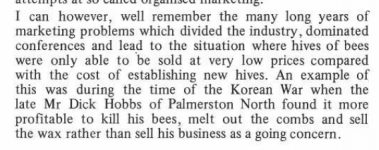https://beekeeping.nz/NZBDA/timeline/1982_03_Wax_recovery_controversy.pdf
Here is a set of articles and letters from the NZ Beekeeper magazine, in 1982-1983. They highlight an issue that has probably always existed in beekeeping - that of an intensive versus an extensive approach to things...
The first article described Sandy Richardson's minimal input wax rendering system which avoided both boilers and presses.
But it was Stuart Tweedale's 'one stage wax processing' that caused the most controversy. Stuart was a WWII returned serviceman who got resettled as a beekeeper. But beekeeping in Taihape, the area he was provided, would have been hard work indeed. Stuart and son Don developed an admirable business in a difficult area through times of poor honey prices. Another returned serviceman, Peter Pegram, was also mentioned in the article (having made a similar wax processing system). Peter and later his son Keith developed a successful beekeeping business in similar circumstances near Wairoa. Neither business would have had a lot of loose capital through many of those years, and paid staff would have been minimal.
All's fine to here - but then Harry Cloake weighed in with the next magazine. He describes the previous equipment as "Heath Robinson", and claimed that the beeswax left behind by such units was significant.
Harry Cloake was a beekeeper who did most everything intensively - his hive management, his wax dipping, honey extraction, queen rearing. He employed considerably more labour than Tweedale or Pegram, and kept them over winter (not always common then). So his approach to wax rendering was the same - relatively high capital value for the equipment, and labour intensive - but with the expectation that the additional wax recovered would more than pay for it.
The next article described the unit (from Steve Robins - it had been originally made by Steve's father Len Robins) that Harry Cloake preferred. It was relatively involved, both in construction and in use. Cloake claimed that the pressing of the hot slum gum gave enough value to justify the costs.
By this time, Stuart Tweedale had taken exception to some of Harry Cloake's previous letter! His reply to Harry is a mildly-offensive delight to read. Stuart makes some obscure references (He refered to Harry's storage of honey in a plastic lined pit during a more than bumper season!) and effectively defends his wax recovery system. And it was really down to extensive versus intensive!
Harry used one last letter to the Editor to defend the intensive wax rendering systems.
But right at the end of the whole thing? Robin Jansen claims that it was *him* that made the rendering system that Stuart Tweedale was using!
Just about every beekeeper has to make those decisions about intensive vs extensive, for just about every aspect of beekeeping, I guess.
Here is a set of articles and letters from the NZ Beekeeper magazine, in 1982-1983. They highlight an issue that has probably always existed in beekeeping - that of an intensive versus an extensive approach to things...
The first article described Sandy Richardson's minimal input wax rendering system which avoided both boilers and presses.
But it was Stuart Tweedale's 'one stage wax processing' that caused the most controversy. Stuart was a WWII returned serviceman who got resettled as a beekeeper. But beekeeping in Taihape, the area he was provided, would have been hard work indeed. Stuart and son Don developed an admirable business in a difficult area through times of poor honey prices. Another returned serviceman, Peter Pegram, was also mentioned in the article (having made a similar wax processing system). Peter and later his son Keith developed a successful beekeeping business in similar circumstances near Wairoa. Neither business would have had a lot of loose capital through many of those years, and paid staff would have been minimal.
All's fine to here - but then Harry Cloake weighed in with the next magazine. He describes the previous equipment as "Heath Robinson", and claimed that the beeswax left behind by such units was significant.
Harry Cloake was a beekeeper who did most everything intensively - his hive management, his wax dipping, honey extraction, queen rearing. He employed considerably more labour than Tweedale or Pegram, and kept them over winter (not always common then). So his approach to wax rendering was the same - relatively high capital value for the equipment, and labour intensive - but with the expectation that the additional wax recovered would more than pay for it.
The next article described the unit (from Steve Robins - it had been originally made by Steve's father Len Robins) that Harry Cloake preferred. It was relatively involved, both in construction and in use. Cloake claimed that the pressing of the hot slum gum gave enough value to justify the costs.
By this time, Stuart Tweedale had taken exception to some of Harry Cloake's previous letter! His reply to Harry is a mildly-offensive delight to read. Stuart makes some obscure references (He refered to Harry's storage of honey in a plastic lined pit during a more than bumper season!) and effectively defends his wax recovery system. And it was really down to extensive versus intensive!
Harry used one last letter to the Editor to defend the intensive wax rendering systems.
But right at the end of the whole thing? Robin Jansen claims that it was *him* that made the rendering system that Stuart Tweedale was using!
Just about every beekeeper has to make those decisions about intensive vs extensive, for just about every aspect of beekeeping, I guess.



